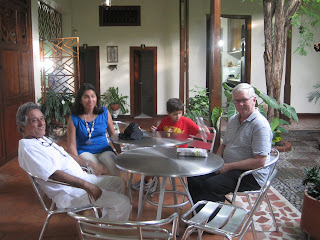Today we took a drive into the countryside to visit Lucero’s in-laws in the small town of Buga, about 80 km north-east of Cali. The normally bad traffic in Cali was made worse this morning by two fender-benders that snarled the roads we were on.
Eventually we made it through the city and drove east past the airport to Palmira, before turning north and driving through fields of sugar cane and past sugar mills where the cane is turned into sugar for shipment domestically and internationally. The mountains of the west (Occidental) Cordillera visible on the left and the mountains of the central Cordillera closer on the right. The mountains on the right rise to almost 5,000 meters and are significantly higher than in the west where the highest peaks struggle to reach 3,000 meters and most are below 2,000 meters.
Buga is one of those towns where not much has changed architecturally in the last few hundred years. The city is famous mainly for the miracle that occurred 300 years ago when a statue of Jesus was found that inexplicably grew to life size, dripped blood from wounds left by the nails on the cross and cured people of ailments. We visited the cathedral built to house the statue last time we were in Colombia, so this time we walked through the narrow streets admiring the architecture and looking for a post office to mail post cards.
Many of the town’s streets are narrow thoroughfares built for horses and the occasional carriage. The houses on the sides of the street have entry doors that are tall and wide enough for a man to enter riding a horse. The entry doors lead into an inner courtyard open to the sky where the rider dismounted. The rooms of each residence were built around the courtyard.
The streets around the center contain shops and churches, below is one example of a store in one of the main streets leading to the main square.
This is one of the many churches in this strongly catholic town
And this is the church where Lucero and Humberto were married
And this is the town square with Manuel-Jose in the center of the picture feeding the pigeons.
After we found the post office, now called 4/72 Postale (after the latitude and longitude of the center of Colombia) and paid $3 each to send postcards to mum and Sofia we stopped at a café for Champus and Pandebono. Champus is Lulu juice (a Colombian fruit), pineapple, cooked corn, panella (brick brown sugar) and naraja (orange) tree leaves. Pandebono is Colombian cheese and bread dough made from Jucca, formed into rolls and cooked in the oven. Both Champus and pandebono are delicious. The picture below shows Rodolfo (Lucero’s father in law), Lucero, Manuel -Jose and me.
Friday, November 26, 2010
Subscribe to:
Post Comments (Atom)







No comments:
Post a Comment